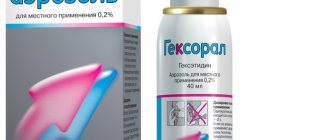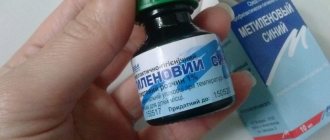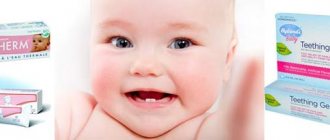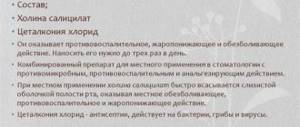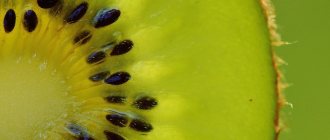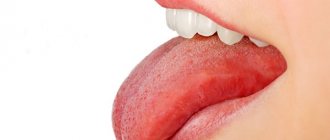22640
Lugol is one of the drugs whose action and effectiveness have been tested over the years. Today, this remedy remains no less popular than it was several decades ago.
The drug has a wide range of indications and is used to solve problems in various fields of medicine , including dentistry.
What does it represent?
Lugol's is distinguished by its simplicity of composition and use, due to which it is used to relieve dental problems in both adults and children.
The drug has shown particular effectiveness in the treatment of stomatitis..
Compound
Positive results in treatment can be achieved by the components included in Lugol's composition.
The active ingredients used here are:
- iodine (1 g);
- glycerol (94 g);
- potassium iodide (2 g).
The role of the base is played by water, which is contained in small quantities. There are only 3 g of water per 100 g of solution.
The limited number of components reduces the likelihood of developing an allergy to this drug and allows it to be used to treat stomatitis even in the youngest children.
Release form
Nowadays, the drug has become so in demand that many manufacturers have begun to produce Lugol not only in the classic version, but also in the form of a spray. The solution and spray are for topical use only .
The solution is produced in bottles of 25 g. The drug in the form of a spray goes on sale in bottles of 50 ml. Each bottle is equipped with a removable dispenser.
Lugol's spray form is used primarily in the treatment of adults, since it can cause bronchospasm in young children.
Different forms of release have different prices. The most expensive option is the drug in the form of a spray, although its price is within 150 rubles.
The cost of the solution is much lower and is only 20 rubles. Each buyer prefers a form that is more profitable and convenient for him.
But it is worth noting that buying a spray allows you to use the product more economically . In addition, its bottle holds a larger volume of liquid.
We will discuss how to treat stomatitis in a child in a separate publication.
In the next article we provide instructions on how to use vinylin for stomatitis in children.
Using the link https://www.vash-dentist.ru/lechenie/bolezni-polosti-rta/stomatit-bpr/kak-i-chem-u-vzroslyih.html we’ll talk about how to properly treat stomatitis in the mouth in adults.
Composition of Lugol
Lugol contains the following components:
- iodine;
- glycerol;
- potassium iodide
The main active ingredients are potassium iodide and iodine, which are soluble in glycerin.
The drug was originally created by Jean Lugol in 1829, but not to treat stomatitis, but to combat pulmonary tuberculosis. After some time, doctors realized that Lugol's with glycerin was not suitable for combating tubercle bacillus, but they appreciated the ability of this remedy to treat infectious and inflammatory diseases of the skin and mucous membranes.
How does it work?
The effectiveness of the drug is explained by the combination of substances included in the composition. Upon contact with mucous membranes and skin, Lugol quickly penetrates into their deep layers and begins to work actively.
Potassium iodide independently has a therapeutic effect and is a catalyst that enhances the effect of iodine. It is a substance that has an antiseptic, local irritant and antifungal effect.
Therefore, this drug is used for all types of stomatitis, including those caused by fungi.
The main therapeutic effect here is exerted by iodine, which is presented in a high-molecular form. It has a pronounced bactericidal effect against both gram-positive and gram-negative flora.
Staphylococcus bacteria are particularly resistant to iodine, but when used systemically, more than 80% of their total number dies .
After applying the drug to the mucous membranes, a resorptive effect is noted, since the active substances are involved in the process of synthesis of T4 and T3. The irritating effect of iodine is insignificant and leads to improved tissue trophism and normalization of metabolic processes.
Due to the presence of glycerol in the composition, tissues are softened and the drying effect of iodine is neutralized, which can result in tissue irritation. This has a beneficial effect on the healing of the affected surface.
Causes of stomatitis
Stomatitis can occur as an independent disease or as one of the manifestations of general diseases and pathologies of internal organs1.
Among the causes of stomatitis:
- injuries to the oral mucosa: - mechanical, thermal, chemical7;
- diseases of the gastrointestinal tract, for example, gastritis, peptic ulcer of the stomach and duodenum, enteritis, colitis7;
- general bacterial and viral infections - inflammation of the mucous membrane accompanies measles, scarlet fever, diphtheria, in this case the symptoms of stomatitis are accompanied by a sore throat associated with damage to the tissues of the pharynx7;
- blood diseases - leukemia, lymphocytic leukemia, leukemia, agranulocytosis;
- cardiovascular pathology accompanied by circulatory failure;
- diabetes;
- systemic diseases of connective tissue - collagenosis;
- helminthic infestations1,5,8.
Specific stomatitis occurs after toxic and radiation exposure to the body, as well as with syphilis and HIV infection1,5,7,8.
Up to contents
Indications and contraindications
This drug is prescribed for the treatment of children and adults with the following indications :
- pathologies of the upper respiratory tract: tonsillitis, tonsillitis;
- dental diseases: seizures, various forms of stomatitis;
- diseases of the ENT organs: otitis media, rhinitis. Including their purulent forms;
- injuries and burns of a chemical or thermal nature;
- trophic type ulcers;
- atherosclerosis with damage.
The following are contraindications for the use of this product:
- purulent sore throat in advanced form. In this case, Lugol will simply be ineffective;
- allergy to the components of the drug;
- decompensated pathologies of some internal organs: kidneys, liver, thyroid gland;
- dermatitis herpetiformis;
- children under 3 years of age;
- thyrotoxicosis.
Can Hexoral be used for children?
Children under 3 years of age are not prescribed Hexoral solution for rinsing. The aerosol can only be used from 4 years of age. This is due to the high allergenicity of the drug and the presence of a large list of contraindications. If it enters the stomach and bronchi, ethyl alcohol, which is part of Hexoral, can cause poisoning. It is noteworthy that the aerosol contains three times more ethyl alcohol than the solution.
Lollipops are contraindicated for children under 4 years of age due to the presence of benzocaine, which can cause disruption in the functioning of important systems of the growing body. In addition, benzocaine can change the composition of the blood (methemoglobinemia), which can lead to suffocation and blue discoloration of the skin. Hexoral tablets are approved for children over 12 years of age.
There is no special Hexoral spray for children for the reason that children do not know how to properly carry out the irrigation procedure and hold their breath. Thus, the child swallows the drug, which is fraught with unpleasant symptoms.
Terms of use
In order for the product to have the maximum effect in eliminating stomatitis, it is necessary to take into account all the rules for its use.
The procedure for treating mucous membranes should be carried out no less than 30 minutes after eating.
Several methods are used to treat the affected surface :
- Lubricating the inflamed area with a swab containing Lugol's solution. To do this, it is necessary to form a small cotton or gauze swab, which is moistened with the drug and treated with it the oral mucosa.
- Spot treatment of mucosal ulcers and rashes.
To do this, you can wrap a small piece of bandage around your finger and treat the rash. To make this procedure easier, it is recommended to use a pencil or stick with cotton wool wrapped around it. Then, the resulting structure is dipped in Lugol's solution and the product is applied to each ulcer.
In order to properly treat the inflamed areas, it is necessary that the liquid drips a little from the cotton wool. Spend no more than 2–3 seconds on each section. After 3 minutes, you can repeat the procedure.
Up to 3 such treatments can be repeated in one session.
Maximum effectiveness can be achieved if you smear the affected areas every 5 hours for stomatitis in a child, and every 3 hours when treating stomatitis in an adult.
During application of the liquid, a strong burning sensation may be felt, which disappears as the inflammation subsides.
Lesions that occur on the lips are treated using the application method . To do this, form a small flat disk from cotton wool or a bandage, which is heavily moistened with Lugol.
The disc is applied to the affected area for at least 20 minutes. This method of treatment is most often used to relieve stomatitis in adults. No more than 3 applications are allowed per day.
Due to the presence of iodine in the composition, Lugol has a pronounced odor, which, even when applied topically to the mucous membrane, causes a gag reflex.
In this case, it is recommended to use the drug in the form of a spray .
The inflamed mucosa is irrigated 4 to 6 times a day at equal intervals. For the procedure, you need to point the sprayer at the problem area and press on it. To treat the oral cavity of children, 1 click is enough.
For adults, 2-3 sprays are allowed. Irrigation should be carried out after holding your breath and without touching the mucous membranes with the spray.
The Lugol treatment procedure should be carried out over 3 days. A repeated course is allowed only with an interval of 3 days.
How to use Lugol and other home remedies for stomatitis, watch the video:
Main indications for use
Lugol is prescribed for any inflammatory processes of the skin and mucous membranes. The product is used for tonsillitis and other ENT diseases, stomatitis, skin burns, trophic ulcers. The main purpose of the drug is tissue disinfection.
If you suppress the infectious process in time, you can reduce the signs of stomatitis and prevent complications.
You can find a photo of what stomatitis looks like in the mouth on our website.
Despite its wide availability, Lugol for stomatitis should be prescribed by a dentist. Iodine can cause a local allergic reaction and further irritate the mucous membrane. The drug is used especially carefully to treat stomatitis in a child. Read the instructions carefully and consult your doctor first.
Possible side effects
During the period of use of Lugol, side effects :
- irritation of mucous membranes or skin;
- allergic reactions: swelling, redness, burning, itching, hyperemia;
- tachycardia;
- sleep disturbance;
- increased sweating;
- appearance of nervousness;
- diarrhea;
- hives;
- acne;
- lacrimation;
- rhinitis;
- increased saliva production;
- overactivity of the thyroid gland, which leads to thyrotoxicosis;
- dysfunction of the vascular system;
- enlargement of the submandibular lymph nodes.
Types of stomatitis
Due to the variety of types of inflammation of the mucous membrane, it is impossible to describe them all within the framework of the article. The most common forms of the disease are:
- catarrhal;
- ulcerative;
- aphthous: acute and chronic.1,4,8
Catarrhal stomatitis
Catarrhal stomatitis develops most often with violation of the rules of oral hygiene, a large amount of soft and hard dental plaque, and the use of dental prostheses1,4,6.
What does catarrhal stomatitis look like?
The mucous membrane of the oral cavity, gums and gingival papillae, the mucous membrane of the inner surface of the cheeks, as well as the tongue and palate are red, swollen, covered with a white coating, which can then turn brown. Eating causes pain, the mucous membrane begins to bleed at the slightest irritation1.
With simple catarrhal inflammation, only the superficial layer of the oral mucosa is affected, so this stomatitis is quite easy to treat. If stomatitis does not go away, this is a reason to examine the gastrointestinal tract1,4.
Ulcerative stomatitis
Ulcerative stomatitis can develop as a complication of catarrhal disease or as a separate pathology. Most often it occurs against the background of gastric and duodenal ulcers, chronic enteritis, sometimes with diseases of the cardiovascular system, and general infections1,4,5,6.
In the ulcerative form of stomatitis, the entire thickness of the mucous membrane is affected4. Initially, areas of redness and swelling appear on it (usually under the tongue and on the buccal surface). There is a burning sensation in the mouth, which intensifies when eating4,5. On the 2-3rd day of the disease, a dirty gray plaque forms at the site of the lesion, and after its rejection, painful ulcers appear1,5.
Ulcers can be single or multiple, sometimes they merge with each other and form extensive ulcerated areas. The volume of the lesion determines the severity of the disease. Thus, with severe inflammation, symptoms of general intoxication are observed: weakness, increased fatigue, headache, fever up to 37.50 C1,4,5,6.
In addition to the listed symptoms, with ulcerative stomatitis, the lymph nodes under the lower jaw and on the anterolateral surface of the neck enlarge4,5,6. Saliva becomes viscous, viscous, the smell from the mouth becomes fetid, putrefactive1.5.
How many days does ulcerative stomatitis last? Proper treatment started in a timely manner promotes healing of ulcers within 8-10 days. If you do nothing and wait until the stomatitis goes away on its own, the inflammation can spread deeper and involve the jaw bones - osteomyelitis will develop1,5.
Aphthous stomatitis
Aphthous stomatitis is characterized by the formation of single or multiple aphthous stomatitis on the oral mucosa1,2,3,4,6.
Aphthae are round-shaped formations, the size of a lentil grain, with a grayish-yellowish coating in the center and a narrow rim of redness along the periphery4,6,9. After the plaque is rejected, a small and extremely painful ulcer forms in the center of the aphthae, which, when healing, turns into a red spot. This spot lasts only a few days and then disappears without a trace1,3,9.
Aphthous inflammation can occur in acute and chronic forms1,2. In acute cases, the appearance of aphthae during stomatitis is accompanied by pain in the mouth, weakness, weakness, and increased body temperature4. As the rash disappears during treatment of stomatitis, the condition quickly improves - recovery is observed1,3.
With chronic aphthous inflammation, there are no general symptoms, and the number of emerging aphthae is limited to 1-3. The disease exists for many years, worsening mainly in spring and autumn1,2,3.
How long does aphthous stomatitis last? With proper treatment, its manifestations disappear within 7-10 days1,2,3. Acute forms of pathology may never recur, and chronic inflammation may not bother you for a long time or, conversely, worsen with the slightest decrease in immunity1,2,3,9.
Up to contents
Analogues of the drug
Now on pharmacy shelves there are a large number of drugs similar to Lugol in composition and action. Despite their different composition, they have the same effectiveness.
Read how to treat stomatitis in adults at home in the next magazine review.
This material is devoted to the treatment of mouth ulcers in children.
Here https://www.vash-dentist.ru/lechenie/bolezni-polosti-rta/stomatit-bpr/samyie-populyarnyie-i-deystvennyie-mazi.html we will tell you how effective oxolinic ointment is for stomatitis.
The most popular analogues are::
- Betadine .
The drug is presented in two forms: as an ointment and a solution for topical use. The active substance here is povidone-iodine, enhanced with macrogol. The drug is prescribed for treating the mucous membrane up to 3 times a day. The average cost of Betadine is about 250 rubles. - Aquazan .
It is a solution for local application, where the active component is the same povidone-iodine. Apply it 3 times a day. But unlike the first option, the cost of this drug is several times lower and does not exceed 60 rubles. - Dentamet .
This product is analogous not in composition, but in action. It is based on chlorhexidine and metronidazole. The drug is treated with the mucous membrane for 7 to 10 days, applying it to the affected areas 2 times a day. The cost of the product does not exceed 150 rubles. - Laripront .
Presented in the form of lozenges. The main active components here are lysozyme and dequalinium chloride. Tablets are used every 2 hours in adults and every 3 hours in children. Treatment is carried out until visible improvement or complete recovery. The price of this drug is about 200 rubles. - Strepsils - tablets intended for resorption. The main components are dichlorobenzyl alcohol and amylmetacresol.
Designed for dissolving tablets every 3 hours. But it should be borne in mind that taking more than 8 tablets per day is not allowed. The drug should not be taken for more than 3 days.Its cost is from 200 to 450 rubles, depending on the number of tablets in the package.
- Metrohex - this gel includes components such as chlorhexidine and metronidazole.
The drug is applied 3 times a day to the inflamed areas for 5–7 days. The cost of the product can vary from 80 to 250 rubles.
How to use Hexoral for stomatitis
Hexoral is most effective for herpetic and fungal stomatitis. In addition to stomatitis, Hexoral helps with laryngitis, pharyngitis, tonsillopharyngitis, purulent sore throat, colds and fungal infections. It must be remembered that any drug is fully effective only when it is used in accordance with the instructions.
If a solution was prescribed for the treatment of ulcers, treatment should be carried out twice a day after meals. You need to moisten a cotton swab with the solution and apply it to the affected area for 30 seconds. When using an aerosol, spray within two seconds. It is important not to swallow saliva for a while after the procedure.
The duration of the therapeutic course is determined only by the doctor, taking into account the severity of the disease. Hexoral is not used as monotherapy. Stomatitis can only be cured in a comprehensive way: diet, bed rest, drugs that strengthen the immune system.
Reviews
Numerous reviews confirm the effectiveness of this drug. Most users claim that a positive result is observed after a single use.
We invite you to share your opinion about Lugol in the comments to this article.
If you find an error, please select a piece of text and press Ctrl+Enter.
Tags treatment treatment of stomatitis Lugol stomatitis
Did you like the article? stay tuned
Previous article
Does garlic help with toothache?
Next article
Recommendations for using a caries marker
What can be replaced?
Lugol is not suitable for some children: it causes allergic symptoms and worsens the course of stomatitis. It happens that this drug is not available at home or in the pharmacy. In such cases, it is worth purchasing a substitute product.
Gel Dentamet
Lugol's analogues are:
- Laripront;
- Betadine;
- Aquazan;
- Dentamet;
- Strepsils;
- Metrohex.
Substitutes have a different composition, but also have an antiseptic, anti-inflammatory effect, and are good for stomatitis. It is not advisable to change Lugol for another product on your own.
Write a comment
Albina
October 27, 2021 at 01:04 pm
I would also like to add: be sure to consult a doctor before use and make sure that there are no allergies or contraindications. Self-medication is a dangerous business. I myself suffer from stomatitis, it constantly appears seasonally in spring and autumn. I tried Lugol, it helped quickly, but it gave me acne, but sometimes it’s worth making such sacrifices just to not experience this stomatitis pain while eating.
Julia
October 30, 2021 at 0:00
I took this medicine several years ago. It helps very well, the taste is really unpleasant, but tolerable. Treated sore throat. Within four days, all symptoms of the disease disappeared. Inexpensive and effective. It's good that they released the spray. My mother developed ulcers on the oral mucosa. In such places that you can’t reach it with cotton wool, and it hurts. It will be easier to spray.
Tina
October 30, 2021 at 7:30 am
Despite a bunch of side effects, none of them were observed during my treatment of my children. By the way, as a child, my mother saved me only with Lugol, a terribly unpleasant, but very effective medicine. It is not expensive, compared to other medications for stomatitis, it is available to everyone, and this is a very big plus. I always have it in my home medicine cabinet. It became very convenient to use it when manufacturers began to produce Lugol in spray form.
Olga
November 12, 2021 at 12:00
Wow, this is the first time I’ve heard that Lugol is used for stomatitis. I usually smeared it with some kind of nasty-tasting gel. They write above that the taste is unpleasant, but in my opinion Lugol has normal taste, not so unpleasant, I don’t know what it depends on. It’s just that you get a little scared when you read such a huge list of side effects, but I think that if my daughter sprayed it from her throat, nothing will happen if I spray it on the ulcers, but I’ll still consult with the pediatrician.
Inna
November 18, 2021 at 03:03 pm
I don’t understand, why engage in perversion? Well, in some emergency cases, when you find “Lugol” hunters in the winter hut far from civilization, well, you can probably use what is called “for lack of a maid...”. But if there is a pharmacy, it is better to buy specialized drugs “Ingalipt spray”, “Cholisal” or what else is sold in pharmacies? Why have a janitor when you have a maid? Or are we not looking for easy ways? I believe that boots should be made by a shoemaker and pies should be made by a pie maker. If the drug is intended to treat a sore throat, then they need to treat a sore throat. Even if it has a similar active ingredient, which is also suitable for the treatment of stomatitis. Because, in addition to the general active ingredient, there may be a bunch of components that are necessary for the treatment of sore throat, but... not needed or even harmful for stomatitis.
Irina
December 27, 2021 at 8:20 am
I always used Lugol only to treat sore throat, I didn’t even think that stomatitis could be treated with it. So far I haven’t had stomatitis, but if I do, I’ll try to use it. Very convenient, which comes in the form of a spray. Sprayed it wherever needed, and that was it. I consider it very effective, our grandmothers were treated with iodine and everything is fine. And the price is not that expensive compared to other sprays.
Hexoral during pregnancy
Doctors do not consider pregnancy a direct contraindication to the treatment of stomatitis with Hexoral. However, there are no reliable studies that would refute the danger of the drug for pregnant women and nursing mothers (WHO prohibits any studies involving such patients).
Since Hexoral has a local effect, it minimizes the effect on the fetus. In any case, treatment of stomatitis with this drug can only be carried out with the permission of the attending physician. Often, strong drugs, like Hexoral, are prescribed only when stomatitis poses a great threat to the child and mother.
